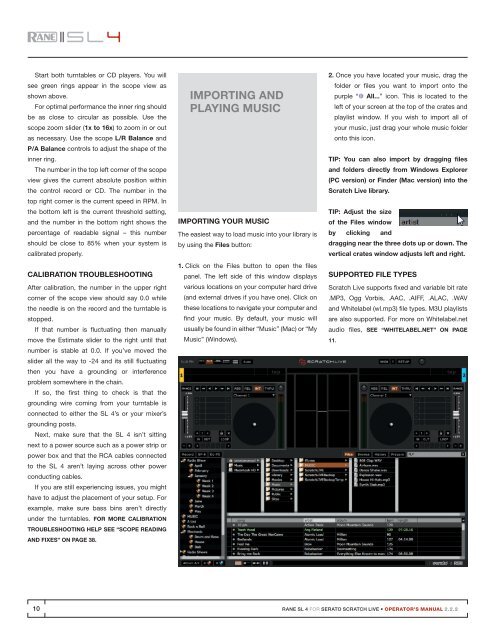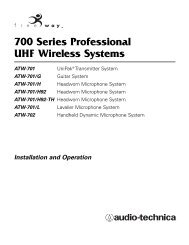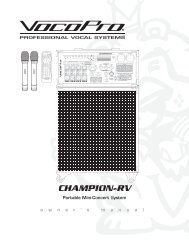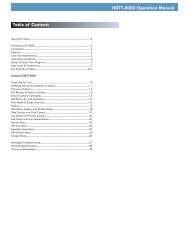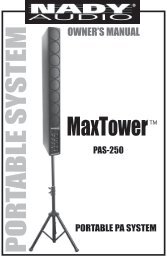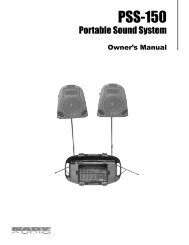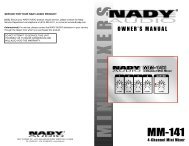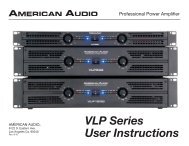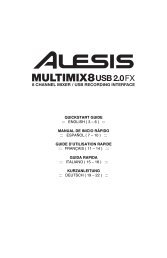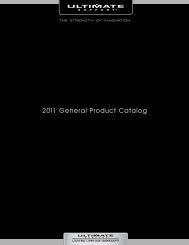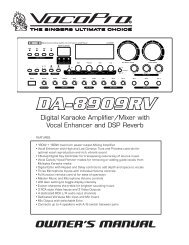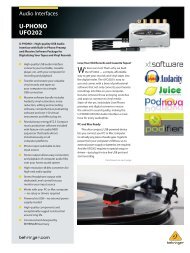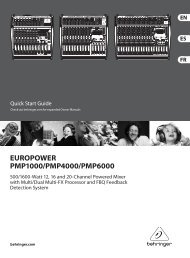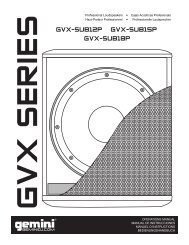SL 4 Manual for Serato Scratch Live 2.2.2 - Juno Records
SL 4 Manual for Serato Scratch Live 2.2.2 - Juno Records
SL 4 Manual for Serato Scratch Live 2.2.2 - Juno Records
Create successful ePaper yourself
Turn your PDF publications into a flip-book with our unique Google optimized e-Paper software.
Start both turntables or CD players. You willsee green rings appear in the scope view asshown above.For optimal per<strong>for</strong>mance the inner ring shouldbe as close to circular as possible. Use thescope zoom slider (1x to 16x) to zoom in or outas necessary. Use the scope L/R Balance andP/A Balance controls to adjust the shape of theinner ring.The number in the top left corner of the scopeview gives the current absolute position withinthe control record or CD. The number in thetop right corner is the current speed in RPM. Inthe bottom left is the current threshold setting,and the number in the bottom right shows thepercentage of readable signal – this numbershould be close to 85% when your system iscalibrated properly.Calibration TroubleshootingAfter calibration, the number in the upper rightcorner of the scope view should say 0.0 whilethe needle is on the record and the turntable isstopped.If that number is fluctuating then manuallymove the Estimate slider to the right until thatnumber is stable at 0.0. If you’ve moved theslider all the way to -24 and its still fluctuatingthen you have a grounding or interferenceproblem somewhere in the chain.If so, the first thing to check is that thegrounding wire coming from your turntable isconnected to either the <strong>SL</strong> 4’s or your mixer’sgrounding posts.Next, make sure that the <strong>SL</strong> 4 isn’t sittingnext to a power source such as a power strip orpower box and that the RCA cables connectedto the <strong>SL</strong> 4 aren’t laying across other powerconducting cables.If you are still experiencing issues, you mighthave to adjust the placement of your setup. Forexample, make sure bass bins aren’t directlyunder the turntables. <strong>for</strong> more CALIBRATIONtroubleshooting help SEE “Scope Readingand Fixes” on page 38.Importing andPlaying MusicImporting Your MusicThe easiest way to load music into your library isby using the Files button:1. Click on the Files button to open the filespanel. The left side of this window displaysvarious locations on your computer hard drive(and external drives if you have one). Click onthese locations to navigate your computer andfind your music. By default, your music willusually be found in either “Music” (Mac) or “MyMusic” (Windows).2. Once you have located your music, drag thefolder or files you want to import onto thepurple “ All...” icon. This is located to theleft of your screen at the top of the crates andplaylist window. If you wish to import all ofyour music, just drag your whole music folderonto this icon.TIP: You can also import by dragging filesand folders directly from Windows Explorer(PC version) or Finder (Mac version) into the<strong>Scratch</strong> <strong>Live</strong> library.TIP: Adjust the sizeof the Files windowby clicking anddragging near the three dots up or down. Thevertical crates window adjusts left and right.Supported File Types<strong>Scratch</strong> <strong>Live</strong> supports fixed and variable bit rate.MP3, Ogg Vorbis, .AAC, .AIFF, .ALAC, .WAVand Whitelabel (wl.mp3) file types. M3U playlistsare also supported. For more on Whitelabel.netaudio files, see “Whitelabel.net” on PAGE11.10RANE <strong>SL</strong> 4 FOR SERATO SCRATCH LIVE • OPERATOR’S MANUAL <strong>2.2.2</strong>


